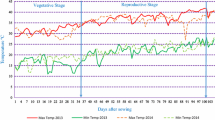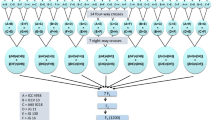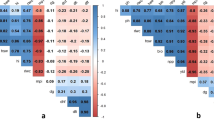Abstract
Heat is a major abiotic stress that drastically reduces chickpea yield. This study aimed to identify heat-responsive traits to sustain crop productivity by screening a recombinant inbred line (RILs) population at two locations in India (Ludhiana and Faridkot). The RIL population was derived from an inter-specific cross between heat-tolerant genotype GPF 2 (C. arietinum L.) and heat sensitive accession ILWC 292 (C. reticulatum). The pooled analysis of variance showed highly significant differences for all the traits in RILs and most of the traits were significantly affected by heat stress at both locations. High values of genotypic coefficient of variation (19.52–38.53%), phenotypic coefficient of variation (20.29–39.85%), heritability (92.50–93.90%), and genetic advance as a percentage of mean (38.68–76.74%) have been observed for plant height, number of pods per plant, biomass, yield, and hundred seed weight across the heat stress environments. Association studies and principal component analysis showed a significant positive correlation of plant height, number of pods per plant, biomass, hundred seed weight, harvest index, relative leaf water content, and pollen viability with yield under both timely-sown and late-sown conditions. Path analysis revealed that biomass followed by harvest index was the major contributor to yield among the environments. Both step-wise and multiple regression analyses concluded that number of pods per plant, biomass and harvest index consistently showed high level of contribution to the total variation in yield under both timely-sown and late-sown conditions. Thus, the holistic approach of these analyses illustrated that the promising traits provide a framework for developing heat-tolerant cultivars in chickpea.




Similar content being viewed by others
Code availability
Not applicable.
Abbreviations
- ANOVA:
-
Analysis of variance
- BIO:
-
Biomass
- DHF:
-
Days to 100% flowering
- DFF:
-
Days to 50% flowering
- DFI:
-
Days to flowering initiation
- DG:
-
Days to germination
- GAM:
-
Genetic advance as percent of mean
- G × E:
-
Genotype × environment interaction
- GCV:
-
Genotypic coefficient of variation
- HI:
-
Harvest index
- HSW:
-
Hundred seed weight
- MAS:
-
Marker assisted selection
- MPI:
-
Membrane permeability index
- NPP:
-
Number of pods per plant
- PCV:
-
Phenotypic coefficient of variation
- PH:
-
Plant height
- PV:
-
Pollen viability
- PCA:
-
Principal component analysis
- RILs:
-
Recombinant inbred lines
- RLWC:
-
Relative leaf water content
- YLD:
-
Yield
References
Abbo S, Berger JD, Turner NC (2003) Evolution of cultivated chickpea: four genetic bottlenecks limit diversity and constrain crop adaptation. Funct Plant Biol 30:1081–1087
Allard RW (1960) Principles of plant breeding. John Wiley and Sons Inc, New York
Basu PS, Ali M, Chaturvedi SK (2009) Terminal heat stress adversely affects chickpea productivity in northern India- Strategies to improve thermo tolerance in the crop under climate change. Workshop Proceedings, impact of climate change on agriculture, pp. 23–25
Canci H, Toker C (2009) Evaluation of yield criteria for drought and heat resistance inchickpea (Cicer arietinum L.). J Agron Crop Sci 195(1):47–54
Chaturvedi SK, Mishra DK, Vyas P, Mishra N (2009) Breeding for cold tolerance in chickpea. Trends Biosci 2:1–6
Cottee NS, Tan DKY, Bange MP, Cothren JT, Campbell LC (2010) Multi-level determination of heat tolerance in cotton (Gossypium hirsutum L.) under field conditions. Crop Sci 50:2553–2564
Devasirvatham V, Tan DKY, Trethowan RM, Gaur PM, Mallikarjuna N (2010) Impact of high temperature on the reproductive stage of chickpea. Proceeding of the 15th Australian Society of Agronomy Conference, Lincoln, New Zealand
Devasirvatham V, Gaur PM, Mallikarjuna M, Tokachichu RN, Trethowan RM, Tan DKY (2012) Effect of high temperature on the reproductive development of chickpea genotypes under controlled environments. Funct Plant Biol 139:1009–1018
Devasirvatham V, Gaur PM, Mallikarjuna N, Tokachichu R, Trethowan R, Tan DKY (2013) Reproductive biology of chickpea response to heat stress in the field is associated with the performance in controlled environments. Field Crops Res 142:9–19
Dewey DR, Lu KH (1959) A correlation and path-coefficient analysis of components of crested wheatgrass seed production. Agron J 51:515–518
FAOSTAT (2017) Statistical Database of the United Nation Food and Agriculture Organization (FAO) Statistical Division Rome Available at: http://www.fao.org/faostat/en/#home. Accessed Sep 2017
Gaur PM, Srinivasan S, Gowda CLL, Rao BV (2007) Rapid generation advancement in chickpea. J SAT Agric Res 3(1):1–3
Gaur PM, Jukanti AK, Srinivasan S et al (2014) Climate change and heat stress tolerance in chickpea. In: Tuteja N, Gill SS (eds) Climate change and plant abiotic stress tolerance. Wiley, Weinheim, pp 839–856
Hamwieh A, Imtiaz M (2015) Identifying water-responsive and drought-tolerant chickpea genotypes. Crop Pasture Sci 66:1003–1011
Howarth CJ (2005) Genetic improvements of tolerance to high temperature. In: Ashraf M, Harris PJC (eds) Abiotic stresses-plant resistance through breeding and molecular approaches. The Haworth Press, USA, pp 277–300
Jivani JV, Mehta DR, Pithia MS, Madariya RB, Mandavia CK (2013) Variability analysis and multivariate analysis in chickpea (Cicer arietinum L.). Electron J Plant Breed 4:1284–1291
Jukanti AK, Gaur PM, Gowda CLL, Chibbar RN (2012) Chickpea: nutritional properties and its benefits. Br J Nutr 108:11–26
Kakani VG, Prasad PVV, Craufurd PQ, Wheeler TR (2002) Response of in vitro pollen germination and pollen tube growth of groundnut (Arachis hypogaea L.) genotypes to temperature. Plant Cell Environ 25:1651–1661
Karim MF, Fattah QA (2007) Growth analysis of chickpea cv bari chhola-6 as affected by foliar spray of growth regulators. Bangladesh J Bot 36(2):105–110
Krishnamurthy L, Gaur PM, Basu PS et al (2011) Large genetic variation for heat tolerance in the reference collection of chickpea (Cicer arietinum L) germplasm. Plant Genet Resour 9:59–61
Kumar J, Gupta DS, Gupta S, Dubey S, Gupta P, Kumar S (2017a) Quantitative trait loci from identification to exploitation for crop improvement. Plant Cell Rep 36:1187–1213
Kumar S, Kumar A, Kumar RR, Roy RK, Agrawal T (2017b) Genetic variability of chickpea genotypes under heat stress condition: correlation and path analysis: based analysis. Ind J Ecol 44(4):59–64
Kushwah A, Gupta S, Bindra S et al (2020) Gene pyramiding and multiple character breeding. In: Singh M (ed) Chickpea crop wild relatives for enhancing genetic gains. Elsevier Academic Press, pp 131–165
Kushwah A, Bindra S, Singh I et al (2020) Advances in chickpea breeding and genomics for varietal development and trait improvement in India. In: Gosal SS, Wani SH (eds) Accelerated plant breeding. Springer, pp 31–66
Ladizinsky G (1975) A new Cicer from Turkey. Notes Roy Bot Gard 34:201–202
Ludlow MM, Muchow RC (1990) A critical evaluation of traits for improving crop yields in water limited environments. Adv Agron 43:107–153
Mallu TS, Nyende AB, Rao NG, Odeny DA, Mwangi SG (2015) Assessment of interrelationship among agronomic and yield characters of chickpea. Int J Agric Crop Sci 8(2):128–135
Maqbool MA, Aslam M, Ali H, Shah TM (2016) Evaluation of advanced chickpea (Cicer arietinum L) accessions based on drought tolerance indices and SSR markers against different water treatments. Pak J Bot 48:1421–1429
Nayyar H, Bains T, Kumar S (2005) Low temperature induced floral abortion in chickpea: relationship with abscisic acid and cryoprotectants in reproductive organs. Environ Exp Bot 53:39–47
Paul PJ, Samineni S, Sajja SB et al (2018) Capturing genetic variability and selection of traits for heat tolerance in a chickpea recombinant inbred line (RIL) population under field conditions. Euphytica 214:27
Porch TG, Jahn M (2001) Effects of high-temperature stress on microsporogenesis in heat-sensitive and heat-tolerant genotypes of Phaseolus vulgaris. Plant Cell Environ 24:723–731
Premchand GS, Sangroka T, Ogatta S (1990) Cell membrane stability as indicators of drought tolerance as affected by applied nitrogen in soybean. J Agric Sci 11:563–566
Purushothaman R, Krishnamurthy L, Upadhyaya HD, Vadez V, Varshney RK (2016) Shoot traits and their relevance in terminal drought tolerance of chickpea (Cicer arietinum L). Field Crops Res 197:10–27
Purushothaman R, Krishnamurthy L, Upadhyaya HD, Vadez V, Varshney R (2017) Genotypic variation in soil water use and root distribution and their implications for drought tolerance in chickpea. Funct Plant Biol 44:235–252
Renukadevi P, Subbalakshmi B (2006) Correlations and path coefficient analysis in chickpea. Legume Res 29:201–204
Sairam RK (1994) Effect of moisture stress on physiological activities of two contrasting wheat genotypes. Indian J Exp Biol 32:584–593
Sakata T, Higashitani A (2008) Male sterility accompanied with abnormal anther development in plants–genes and environmental stresses with special reference to high temperature injury. Int J Plant Dev Biol 2:42–51
Sharma KD, Pannu RK, Behl RK (2005) Effect of early and terminal heat stress on biomass portioning chlorophyll stability and yield of different wheat genotypes. Proceeding of the international conference on sustainable crop production in stress environments: management and genetic options, pp. 187–94
Simões-Araújo JL, Rumjanek NG, Margis-Pinheiro M (2003) Small heat shock proteins genes are differentially expressed in distinct varieties of common bean. Braz J Plant Physiol 15(1):33–41
Singh R, Sharma P, Varshney RK, Sharma SK, Singh NK (2008) Chickpea improvement: role of wild species and genetic markers. Biotechnol Genet Eng Rev 25:267–314
Slavik B (1974) Methods of studying plant water relations. Springer-Verlag, Berlin and New York
Thakur SK, Sirohi A (2009) Correlation and path coefficient analysis in chickpea (Cicer arietinum L). Legume Res 32(1):1–6
Thudi M, Upadhyaya HD, Rathore A et al (2014) Genetic dissection of drought and heat tolerance in chickpea through genome-wide and candidate gene-based association mapping approaches. PLoS ONE 9(5):e96758
Toker C, Canci H (2006) Selection for drought and heat resistance in chickpea under terminal drought conditions. 4th international food legumes research conference, food legumes for nutritional security and sustainable agriculture, pp. 18–22
Tongden C, Basant M, Chakraborty U (2006) Screening of thermotolerant cultivars of chickpea using cell membrane stability test and biochemical markers. J Hill Res 19:52–58
Tuberosa R, Salvi S (2006) Genomics-based approaches to improve drought tolerance of crops. Trends Plant Sci 11:405–412
Upadhaya HD, Dronavalli N, Gowda CLL, Singh S (2011) Identification and evaluation of chickpea germplasm for tolerance to heat stress. Crop Sci 51:2079–2094
Vadez V, Krishnamurthy L, Thudi M et al (2012) Assessment of ICCV 2 9 JG 62 chickpea progenies shows sensitivity of reproduction to salt stress and reveals QTL for seed yield and yield components. Mol Breed 30(1):9–21
Varshney RK, Mohan SM, Gaur PM et al (2013) Achievements and prospects of genomics-assisted breeding in three legume crops of the semi-arid tropics. Biotech Adv 10:1016–1022
Varshney RK, Thudi M, Nayak SN et al (2014) Genetic dissection of drought tolerance in chickpea (Cicerarietinum L). Theor Appl Genet 127(2):445–462
Wang J, Gan YT, Clarke F, McDonald CL (2006) Response of chickpea yield to high temperature stress during reproductive development. Crop Sci 46:2171–2178
Wasson AP, Richards RA, Chatrath R et al (2012) Traits and selection strategies to improve root systems and water uptake in water-limited wheat crops. J Exp Bot 63:3485–3498
Weerakoon WMW, Maruyama A, Ohba K (2008) Impact of humidity on temperature induced grain sterility in rice (Oryza sativa L). J Agron Crop Sci 194:134–140
Zaman-Allah M, Jenkinson DM, Vadez V (2011) Chickpea genotypes contrasting for seed yield under terminal drought stress in the field differ for traits related to the control of water use. Funct Plant Biol 38:270–281
Funding
The INSPIRE research grant provided to the AK by Department of Science and Technology (DST), New Delhi, India and research grant provided under the project ‘Incentivizing Research in Agriculture’ by Indian Council of Agricultural Research, New Delhi to SS for carrying out the research are highly acknowledged.
Author information
Authors and Affiliations
Contributions
AK, GS, SS and IS designed and conducted the experiments. DB, AK, SB and SV performed the data analysis. AK, DB, SV and SS prepared and edited the final manuscript.
Corresponding author
Ethics declarations
Conflict of interest
All authors declare that there are no conflicts of interest.
Ethics approval
Not applicable.
Availability of data and material
Not applicable.
Additional information
Publisher's Note
Springer Nature remains neutral with regard to jurisdictional claims in published maps and institutional affiliations.
Supplementary Information
Below is the link to the electronic supplementary material.
Rights and permissions
About this article
Cite this article
Kushwah, A., Bhatia, D., Singh, G. et al. Phenotypic evaluation of genetic variability and selection of yield contributing traits in chickpea recombinant inbred line population under high temperature stress. Physiol Mol Biol Plants 27, 747–767 (2021). https://doi.org/10.1007/s12298-021-00977-5
Received:
Revised:
Accepted:
Published:
Issue Date:
DOI: https://doi.org/10.1007/s12298-021-00977-5




